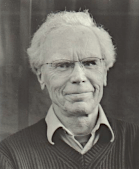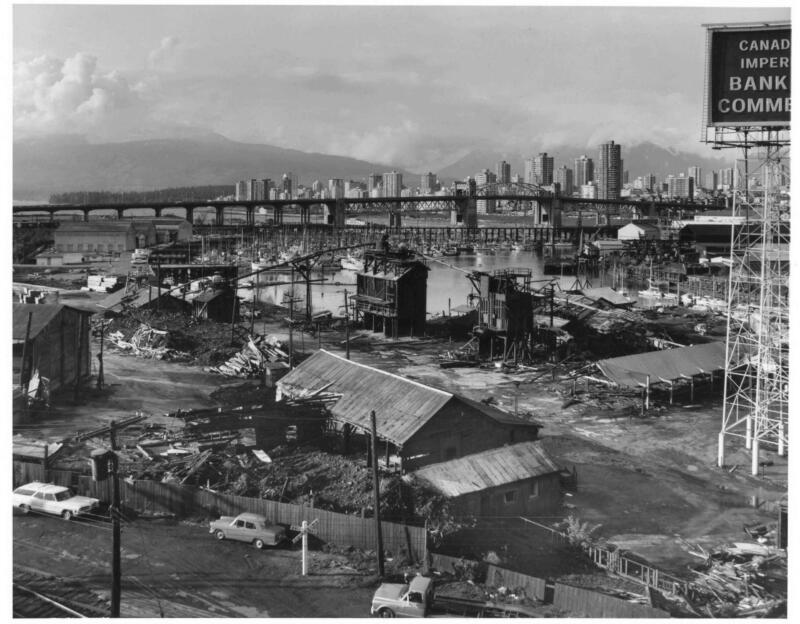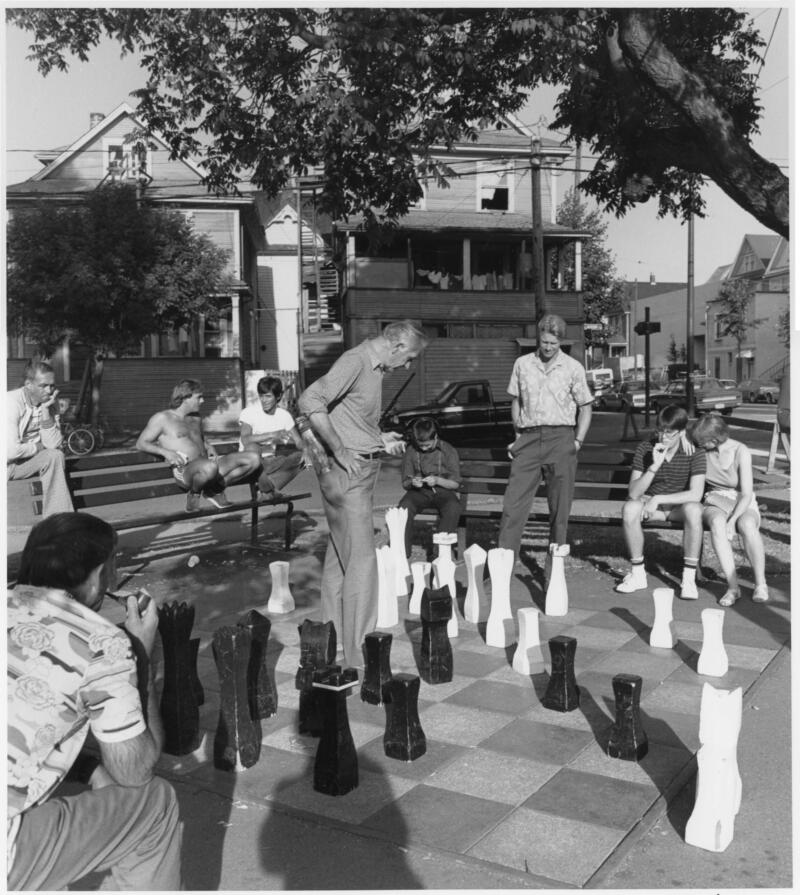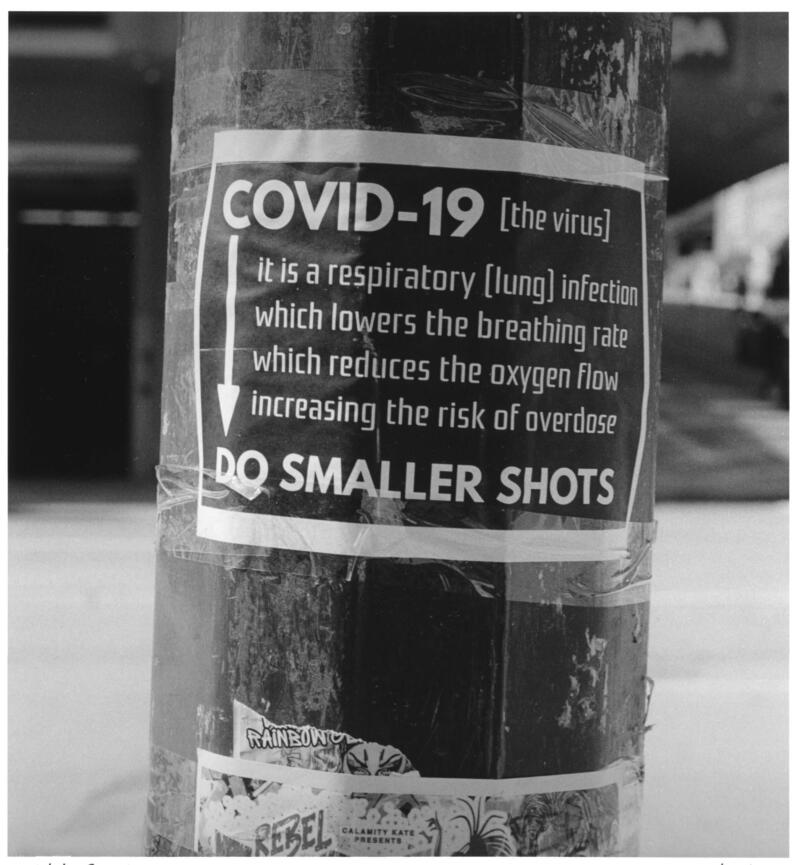1412 Trevor Martin’s Vancouver
PHOTO ESSAY: Trevor Martin: Vancouver photographer
by Bill Paul
*

Originally from Cornwall, England, Trevor Martin started taking photographs there in 1960 before coming to Canada in 1969. He is known for his images of Vancouver, the Canadian Prairies, the American Southwest, England, Paris, Rome, and Sicily.
Here, Bill Paul shares a small sample of Trevor Martin’s Vancouver photos. He writes:
For the past 50 years, Trevor has photographed Vancouver street scenes, public protests, downtown architecture, the Nitobe Memorial Garden and the COVID-19 health crisis. Part of the appeal of his photographs is how they evoke a memory, express an idea or tell a story about Vancouver. Martin is an observational photographer and part of a documentary tradition of photographing Vancouver. His black and white photographs are historical documents; carefully observed pictures, rich with information and telling details. His work reveals the character of Vancouver, its social history. The photographs are part social realism, part urban landscapes.
We present Bill Paul’s photo essay, “Trevor Martin: Vancouver photographer,” introducing Martin’s Vancouver photos from his arrival in Vancouver in 1969 to the Covid epidemic. Trevor Martin can be reached by email at: vtmartin@shaw.ca — Richard Mackie
*
Trevor Martin: Vancouver photographer. Displayed on the walls of Trevor Martin’s office-darkroom are some of his framed black and white photographs of Vancouver. Many of the pictures are taken at street level. Others taken from a bridge or a rooftop offer a wide, broad view of the city. The pictures have a rich mixture of grey and black tones. The pictures pull you in and hold your interest.
In one of his binders is a photograph taken on Easter Sunday, 1971. Martin is at the annual Be-In held at Stanley Park. Wandering among a crowd of university students and young people, he takes a picture of a young man slapping a drum. With his dark shaggy hair, the young man resembles a character torn from the pages of a 19th century boys’ adventure novel.

Four years later in early December on the eve of a bitterly fought provincial election between the New Democratic Party and the Social Credit party, Martin makes his way to the Pacific Coliseum. The Socreds are holding a rally there and Martin photographs a group of supporters wearing straw boater hats featuring the campaign slogan WORK WITH BENNETT. The picture introduces us to the partisan world of provincial politics.

Martin is an observational photographer, part of a longstanding documentary tradition of photographing Vancouver. He’s criss-crossed the city with his camera recording specific places, private moments, public events, historic and newer buildings. His carefully observed black and white photographs are part social realism, part urban landscapes.
Aware and sensitive to how the city has changed over the past 50 years, at times Martin’s pictures reflect the rapid growth that has occurred in Vancouver. The changing face of neighbourhoods. The rise and fall of buildings. Part of the appeal of the photographs is how they suggest a memory, a story or express an idea about the city’s history.
Consider his panoramic photograph of Vancouver’s skyline (1971). The photograph has a dreamlike quality to it. In the immediate foreground is the False Creek and Granville Island area; a former industrial site fallen on hard times. Empty storage sheds stand next to a run-down saw mill. In the far distance are a long line of high-rise apartment buildings and condominium towers situated in the West End.

For historian Daniel Francis, the picture sums up what the decline of the local manufacturing economy looked like many years ago. Francis, the author of a recent book, Becoming Vancouver (Harbour Publishing, 2021), about the history of the city, told me: “In the 1960s, False Creek was a tremendously busy place. Barges were coming and going every day (with cargo). That was before the transformation of the economy from industrial to high tech and the consumer-oriented economy that we have today.”
Similar in theme to the False Creek-Granville Island photograph (the memory of place) is Martin’s picture showing the demolition of the Almer Hotel (1982). All that remains of the narrow structure is a collapsed building, a tangle of metal wire and broken concrete. Located on West Cordova Street, the Almer was at one time a modest, well-looked-after walk-up residential hotel. It was built in 1912 and later named the Almer in 1925. For years it stood between the St. Francis Hotel and the Grandview Hotel across the street from the CPR station (now the Waterfront Station).

In 1972 Martin photographed a popcorn vendor standing alone on Beach Avenue. The picture is a memorial to a local figure who’s been part of the city’s street life since the 1940s. Growing up in Vancouver, Daniel Francis remembers going on Sunday drives with his family when he was young and buying popcorn from him. In her 2016 memoir They Called Me Number One (Talonbooks, 2016), Bev Sellars recalls the summer when she was twelve-years old and stayed with her older sister in the city’s West End, later telling her two brothers about “this man with a huge popcorn machine that he rolled on wheels.”

Trevor Martin is an old-school photographer who prefers using film and developing his own black and white prints. Married with soft grey hair, he usually can be found in his office-darkroom behind his house. The office includes two bookshelves over-loaded with photography books (from William Henry Fox Talbot to Stan Douglas) and file cabinets stocked with negatives and archival boxes full of photography prints.
When I asked him about his approach to photographing Vancouver, he said:
I’m aware of the social reality of the city and I leave myself open to the total experience of being in the city. The changes in architecture and how light plays onto the street. The changes in technology and what people wear. When I see groups of people I’m aware of how they form a community. I keep my eye open for a certain type of composition.
Martin’s photographs are the kind that attract the attention of urban historians and archivists. He enjoys using his camera as a tool to communicate what he sees in the city. From the glass-walled towers on Burrard Street to the older neighbourhoods bordering the city’s downtown, his photographs reveal the nuances of a place or a situation. His pictures are descriptive, direct, and clear.
Notice his picture of two men playing a game of chess at Oppenheimer Park (1985). Both of the men have a lanky, angular build that mirrors the over-sized chess pieces. One of the spectators watching the chess game is smoking a pipe. In the background, opposite the park some laundry has been put out to dry on the verandah of a Victorian-style house. The entire scene is framed by the overhanging branches of a nearby tree.

A setting that has interested Martin over the years is the city’s beaches. The beach, like the street, offers a fleeting impression of a city. For his photograph of Spanish Banks, Martin found the right place to stand with his camera and then carefully composed a definitive day-at-the beach picture (2020). He told me when he’s out with his camera he’s drawn to certain places and in the Spanish Banks photograph he was trying to bring together specific elements that said, “This is a beach in the summer time.”

In the beginning of the COVID-19 public health crisis, Martin photographed a poster taped to a lamppost (2020). The poster provides explanatory information about COVID-19 and a recommendation is issued to people who use drugs on how to manage their drug use. The photograph is taken in a plain, matter-of-fact manner. The power of the poster lies in its straightforward use of language. Spelled out in white, block lettering, the message is clear: be careful. A reminder that this is a public health emergency unlike any other.

In 1998 the Vancouver photographer Roy Arden wrote an article about Ken Bradshaw, an amateur photographer living in Keno City, Yukon, during the mid-1950s. Arden noted that Bradshaw’s photographs of the area showed that “he took care to include important environmental information in his portraits and often focused on the place itself, in all its quotidian particularity.” He added that Bradshaw’s pictures “gave consideration and weight to everyday life.”
Using a similar kind of empathic documentary approach, Martin has left us with his impressions of Vancouver: the city as a shared public space with communities defined by various social and economic interests. His pictures move back and forth, the past sometimes overlapping with the present. With a close attention to social detail and an intuitive sense of what to include in a photograph, his work adds to our understanding of Vancouver’s recent history — Bill Paul
*




*
References:
Roy Arden. (winter 1998). “Vernacular Photography and Realism.” Canadian Art
Bayview Hotel/Changing Vancouver. changing vancouver. wordpress.com
Michelle Bogre. 2019. Documentary Photography Reconsidered. London, 2019
David Campany. 2020. On Photographs. Thames and Hudson.
Bev Sellars. 2016. They Called Me Number One. Vancouver: Talonbooks
*
The British Columbia Review
Publisher and Editor: Richard Mackie
Formerly The Ormsby Review, The British Columbia Review is an on-line journal service for in-depth coverage of BC books and writers. The Advisory Board consists of Jean Barman, Wade Davis, Robin Fisher, Cole Harris, Hugh Johnston, Kathy Mezei, Patricia Roy, Maria Tippett, and Graeme Wynn. Provincial Government Patron (since September 2018): Creative BC. Honorary Patron: Yosef Wosk. Scholarly Patron: SFU Graduate Liberal Studies.
“Only connect.” – E.M. Forster
9 comments on “1412 Trevor Martin’s Vancouver”
Great article! Very clear and easy to follow narrative.